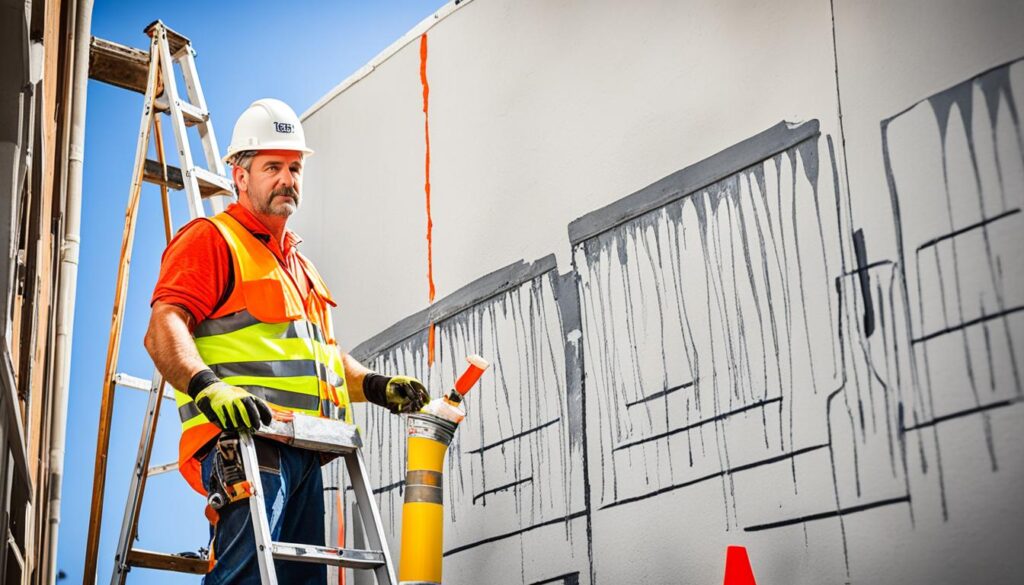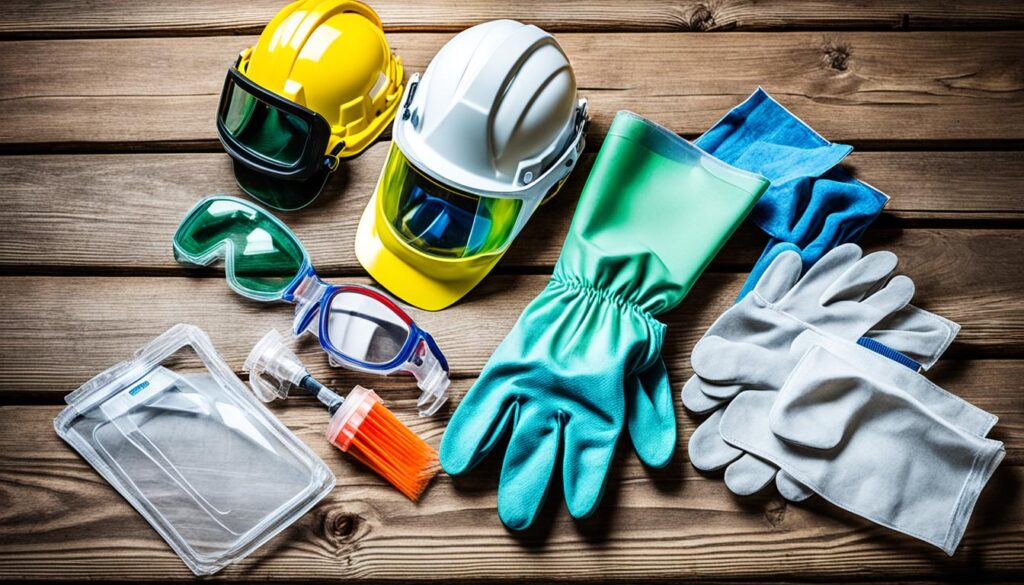
Safety is the top priority in commercial painting. Strict safety measures are vital for everyone’s well-being. This article focuses on key safety steps for a safe work site in commercial painting services.
Key Takeaways
- Comprehensive safety protocols are vital in the commercial painting industry to safeguard workers and clients.
- Identifying potential hazards and conducting thorough risk assessments are crucial to mitigating risks and liabilities.
- Proper personal protective equipment (PPE) and safe work practices like ladder and scaffolding safety are essential for project success.
- Ongoing training and certification for commercial painters ensure they can safely and efficiently handle tasks.
- Adherence to industry standards and regulations is necessary to maintain a safe and compliant work environment.
Importance of Safety Protocols in Commercial Painting
In the realm of commercial painting, safety is key. Safety rules are crucial for keeping workers and clients safe. They also lower the chance of accidents and help avoid legal trouble.
Protecting Workers and Clients
Commercial painting work can be risky. Painters often work in high places and deal with dangerous substances. They must do all they can to keep themselves and the people around them safe.
This means those who hire them, and even bystanders, should not be harmed. Everyone’s safety is vital during painting projects.
Mitigating Risks and Liabilities
Good safety measures lessen the chances of accidents. They also help keep the business from facing legal battles and fines. Plus, a strong safety program enhances a painting company’s reputation.
By taking safety seriously, a company can run smoother, avoid legal issues, and please workers and clients. Thus, a focus on safety is crucial in the commercial painting world. Embark on a reading adventure with this captivating article.
Commercial Painting Safety Protocols
Commercial painting projects must follow strict safety rules. These rules keep workers and clients safe by reducing risks and problems. Here are the safety steps that all painters should know.
Hazard Identification and Risk Assessment
Workers first need to determine what could be dangerous. They examine the job site, tools, materials, and tasks, which helps them implement safety measures to avoid accidents.
Personal Protective Equipment (PPE) Requirements
Using the right personal protective equipment (PPE) is key. This includes hard hats, safety glasses, gloves, and more. When everyone wears the correct PPE, the chance of getting hurt or sick is lower.
Safe Work Practices and Procedures
Following safe methods is vital for a safe work site. This means using ladders and scaffolds correctly, keeping the work area well-ventilated, and controlling air quality. These steps protect workers and clients while following the law.
Training and Certification
Commercial painters must be well-trained and certified. This knowledge and skill make the job safer, and ongoing training shows a commitment to keeping everyone safe.
Following these commercial painting safety protocols makes the work site safe for all. It protects workers and clients and shows the painting industry well.

Hazard Identification and Risk Assessment
Keeping commercial painting projects safe is vital. It involves spotting hazards early and assessing the risks. This allows painting companies to make solid safety plans for their workers and customers.
Identifying Potential Hazards
A key first step is to examine the work area closely to find and point out any hazards. Common dangers include working at heights, dealing with harsh materials, and performing tasks that strain the body.
- Fall risks from working at heights, such as on ladders or scaffolding
- Exposure to hazardous materials, such as paint, solvents, and other chemicals
- Ergonomic issues from repetitive motions or heavy lifting
- Electrical hazards from power tools and equipment
- Slips, trips, and falls on uneven or slippery surfaces
By catching these dangers early, painting companies can make work safer. They do this by taking steps to lower risks.
Assessing the Risks
After finding hazards, it’s time to look at the risks they carry. This step checks how likely accidents are and how bad they could be. Knowing this helps companies focus their safety actions. They put in place the right steps to make things as safe as possible.
The risk assessment process considers a few things. It looks at how often the risk happens, how bad it could be, and if what they do to avoid it works well. This helps create detailed safety planning. It deals with the biggest risks, keeping both workers and clients safe.
Personal Protective Equipment (PPE) Requirements
Safety in commercial painting is a top priority for workers. They need the right personal protective equipment (PPE). This keeps them safe from potential harm while working.
Commercial painters must use different types of PPE. This includes:
- Hard hats for head protection from falling objects
- Safety goggles or face shields for eye safety against paint and debris
- Respiratory protection like masks to avoid breathing in harmful fumes
- Gloves to protect hands from chemicals and cuts
- Sturdy work boots with good grip to prevent falls
- Fall protection equipment for safe work at heights
Companies keep their workers safe by ensuring painters have the right PPE. This helps them follow safety rules and prevent accidents, making the work environment safe for everyone.

Following PPE rules is key to safety in painting projects. It shows that companies care about their workers and want to avoid risk, which helps the painting business stay successful and safe.
Safe Work Practices and Procedures
Keeping a work area safe is crucial for any big painting job. Commercial painters must use many safety methods to protect themselves and those around them. They pay extra attention to two main areas: ladder and scaffolding safety and proper ventilation and air quality control.
Ladder and Scaffolding Safety
Painting jobs often require painting at high places. Using ladders and scaffolding correctly is key to staying safe. Workers should know how to set up and use this equipment properly. It must be in good shape and suited for the job.
Companies must check this equipment often and ensure their workers know and follow safety rules. This keeps everyone safer while working high.
Proper Ventilation and Air Quality Control
Hazardous materials are often used in painting. They can harm the air and our health. Painters must work in a well-ventilated area to keep things safe, and air quality control measures must be in place.
Tools like exhaust fans and air purifiers help keep the air clean. Workers also wear protective gear like masks and suits, which limits the amount of bad stuff they breathe in.
Following these safety steps makes painting jobs less risky. It protects the workers and the clients, ensuring they stay well and free from harm.
Training and Certification for Commercial Painters
Keeping commercial painting projects safe is crucial. This means making sure workers are trained and certified. Painters in this field need to know the right skills and have the correct certifications. This helps them work safely and effectively.
Training includes getting an OSHA certification. This teaches painters about safety rules, how to spot dangers, and ways to reduce risks. Apart from OSHA, painters often need other safety certifications. These could be for working at heights, using scaffolds, or handling dangerous materials.
Service providers invest in their painters by offering continuous training. This isn’t just for the painters’ safety but also to protect clients and reduce risks. With the right training, painters know recent safety rules, top methods, and new tech, making them ready to face any project challenges.
Painting Done by Angels helps people who have lived in the Scottsdale & Phoenix, Arizona regions to make their homes and businesses more beautiful. We are dedicated to providing high-quality exterior and interior painting services. We have 15+ years of expertise in this area. We are a family-owned & operated company that is fully insured, bonded, and licensed so that your investment is safe with us; We strive to provide the best outcomes for our customers every time!
